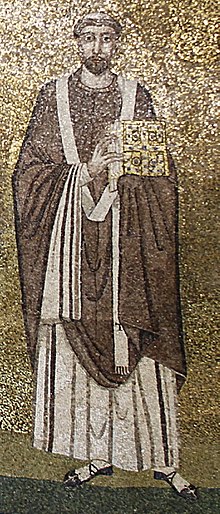498
Appearance
| Millennium: | 1st millennium |
|---|---|
| Centuries: | |
| Decades: | |
| Years: |
| 498 by topic |
|---|
| Leaders |
| Categories |
| Gregorian calendar | 498 CDXCVIII |
| Ab urbe condita | 1251 |
| Assyrian calendar | 5248 |
| Balinese saka calendar | 419–420 |
| Bengali calendar | −95 |
| Berber calendar | 1448 |
| Buddhist calendar | 1042 |
| Burmese calendar | −140 |
| Byzantine calendar | 6006–6007 |
| Chinese calendar | Đinh sửuNiên (FireOx) 3195 or 2988 — to — Mậu dần niên (EarthTiger) 3196 or 2989 |
| Coptic calendar | 214–215 |
| Discordian calendar | 1664 |
| Ethiopian calendar | 490–491 |
| Hebrew calendar | 4258–4259 |
| Hindu calendars | |
| -Vikram Samvat | 554–555 |
| -Shaka Samvat | 419–420 |
| -Kali Yuga | 3598–3599 |
| Holocene calendar | 10498 |
| Iranian calendar | 124 BP – 123 BP |
| Islamic calendar | 128 BH – 127 BH |
| Javanese calendar | 384–385 |
| Julian calendar | 498 CDXCVIII |
| Korean calendar | 2831 |
| Minguo calendar | 1414 beforeROC Dân tiền 1414 niên |
| Nanakshahi calendar | −970 |
| Seleucid era | 809/810AG |
| Thai solar calendar | 1040–1041 |
| Tibetan calendar | Âm hỏa ngưu niên (female Fire-Ox) 624 or 243 or −529 — to — Dương thổ hổ niên (male Earth-Tiger) 625 or 244 or −528 |

Year498(CDXCVIII) was acommon year starting on Thursday(link will display the full calendar) of theJulian calendar.At the time, it was known as theYear of the Consulship ofPaulinusandScytha(or, less frequently,year 1251Ab urbe condita). The denomination 498 for this year has been used since the early medieval period, when theAnno Dominicalendar erabecame the prevalent method in Europe for naming years.
Events
[edit]By place
[edit]Byzantine Empire
[edit]- EmperorAnastasius Iabolishes thechrysargyrontax throughout theEastern Roman Empire,before reforming the monetary system, usingGreek numeralsinstead ofRoman.[1]
Persia
[edit]- Kavadh Ireturns fromexilewith support of 30,000Hephthalites(WhiteHuns), and again assumes theSassanidthrone.He punishes his opponents and probably his brotherDjamasp,who usurped the throne from him.[2]
Japan
[edit]By topic
[edit]Religion
[edit]- November 19–Pope Anastasius IIdies after a 2-year reign in which he has tried to conciliate followers ofAcacius,latepatriarch of Constantinople,who wasexcommunicatedbyFelix III.[4]
- November 22– Anastasius is succeeded bySymmachusas the 51stpope,in the officialpapal selectionin theLateran Palace(Rome). Meanwhile,Antipope Laurentiusis elected "pope" in theBasilica di Santa Maria Maggiore,causing aschism.[5]
- Flavian IIsucceedsPalladiusaspatriarch of Antioch.[6]
Births
[edit]- Jie Min Di,emperor ofNorthern Wei(d.532)[7]
- Kevin of Glendalough,Irishabbotandsaint(d.618)[8]
Deaths
[edit]- November 19–Pope Anastasius II[4]
- Ninken,emperor ofJapan[9]
- Qi Mingdi,emperor ofSouthern Qi(b.452)[10]
References
[edit]- ^Leemans, Johan; Matz, Brian J.; Verstraeten, Johan (2011).Reading Patristic Texts on Social Ethics: Issues and Challenges for the Twenty-First Century.Washington, DC: The Catholic University of America Press. p. 56.ISBN9780813218595.
- ^Magill, Frank Northen; Aves, Alison; Moose, Christina J.; Rehn, Mark (1998).Dictionary of World Biography: The Middle Ages.Vol. II. London and New York: Routledge. p. 559.ISBN9781579580414.
- ^Martin, Peter (1997).The Chrysanthemum Throne: A History of the Emperors of Japan.Honolulu, HI: University of Hawaii Press. p. 33.ISBN9780824820299.
- ^abLoomis, Louise Ropes (2006) [1916].The Book of the Popes (Liber Pontificalis).Merchantville, NJ: Arx Publishing, LLC. pp. 114–115.ISBN9781889758862.
- ^Penn, Imma (2007).Dogma Evolution & Papal Fallacies.Bloomington, IN: AuthorHouse. p. 223.ISBN9781452059945.
- ^Nicholson, Oliver (2018).The Oxford Dictionary of Late Antiquity.Vol. 1. Oxford: Oxford University Press. pp. 1631–1632.ISBN9780192562463.
- ^Ashkenazi, Gary (October 31, 2013)."Byzantine Gold Coin Found in Tomb of Emperor Jiemin of Northern Wei".Primal Trek.RetrievedFebruary 3,2019.
- ^McNally, Frank (May 31, 2018)."The Birdman of Glendalough – An Irishman's Diary about St Kevin".The Irish Times.RetrievedFebruary 4,2019.
- ^Doe, Paula; Dee, Paula; Ōtomo, Yakamochi (1982).A Warbler's Song in the Dusk: The Life and Work of Ōtomo Yakamochi (718-785).Berkeley, Los Angeles, London: University of California Press. pp.6.ISBN9780520043466.
Emperor Ninken 498.
- ^Knechtges, David R.; Taiping, Chang (2014).Ancient and Early Medieval Chinese Literature (vol. 2): A Reference Guide, Part Two.Vol. II. Leiden, Boston: BRILL. p. 1282.ISBN9789004201644.
